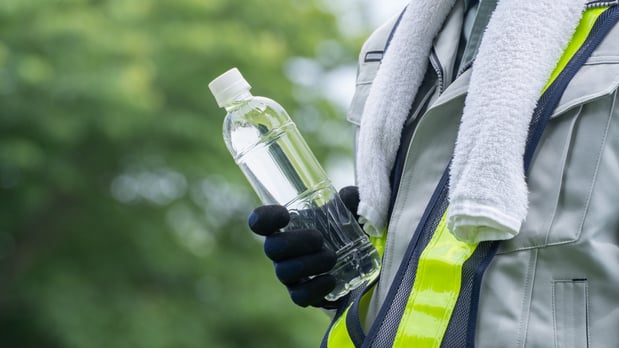The world of work is constantly evolving, and so too are the challenges and priorities surrounding workplace safety.
The Occupational Safety and Health Administration (OSHA) plays a vital role in shaping this landscape, issuing regulations and guidance to ensure safe and healthy work environments for all. Staying informed about current EHS trends and key OSHA topics is critical for businesses of all sizes to ensure compliance, mitigate risk, and foster a culture of safety for their employees. Here’s what you should be aware of as both an employer and a worker when it comes to today’s ever-evolving EHS landscape.

Emerging Trends Shaping the EHS Landscape
- Automation and Robotics: While robots hold vast potential for efficiency and productivity, they introduce new safety challenges. OSHA is focusing on:
-
- Human-Robot Interaction (HRI): Establishing clear guidelines for safe collaboration between humans and robots, including separation zones, training for workers, and emergency stop procedures.
- Machine Guarding: Defining standards for safeguarding robots to prevent accidental contact and injuries.
- Worker Training: Emphasizing specialized training for employees working with robots, covering safe operating procedures, risk identification, and emergency response.

- Mental Health and Wellbeing: Recognizing the link between mental health and workplace safety, OSHA is prioritizing:
-
- Stress Management Resources: Encouraging employers to offer stress management programs like mindfulness training, employee assistance programs (EAPs), and flexible work arrangements.
- Promoting Work-Life Balance: Recognizing the importance of reasonable workloads, clear expectations, and breaks to prevent burnout and fatigue.
- Open Communication: Fostering a culture where employees feel comfortable discussing mental health concerns without fear of stigma or repercussions.
- Musculoskeletal Disorders (MSDs): MSDs remain a significant concern, and OSHA is addressing them through:
-
- Ergonomic Assessments: Encouraging businesses to conduct ergonomic assessments of workplaces to identify and mitigate risks associated with repetitive tasks, awkward postures, and heavy lifting.
- Proper Job Design: Emphasizing the importance of designing jobs with worker comfort and safety in mind, minimizing awkward postures and excessive force requirements.
- Training and Early Intervention: Providing training for employees on proper lifting techniques, posture awareness, and early identification of MSD symptoms.
- Infectious Diseases and Pandemics: The COVID-19 pandemic has served as a stark reminder of the importance of preparedness:
-
- Pandemic Preparedness Plans: Encouraging businesses to develop and regularly update pandemic preparedness plans, including protocols for remote work, communication strategies, and hygiene practices.
- Personal Protective Equipment (PPE): Providing guidance on the appropriate use of PPE like masks, gloves, and respirators based on specific risks and situations.
- Exposure Control: Emphasizing safe handling of potentially infectious materials, proper ventilation systems, and engineering controls to minimize airborne transmission.
- Climate Change and Extreme Weather Events: Climate change presents growing safety challenges:
-
- Heat Stress Prevention: Emphasizing heat stress prevention plans with hydration, access to shade, and monitoring worker well-being in hot environments.
- Emergency Response for Extreme Weather: Encouraging businesses to develop plans for emergencies like floods, wildfires, and power outages, ensuring employee safety and communication protocols.
- Sea Level Rise and Flooding: Addressing the risks associated with rising sea levels and potential flooding events for coastal businesses, including evacuation plans and infrastructure resilience.
Key OSHA Topics in the Spotlight
- Heat Illness Prevention: With rising temperatures and intense heat waves becoming more frequent, heat illness prevention has become a major focus for OSHA. They launched a National Emphasis Program (NEP) targeting high-risk industries like construction, agriculture, and outdoor work. This NEP emphasizes:
-
- Training: Workers must be trained on identifying heat stress symptoms, proper hydration practices, and cool-down strategies.
- Hydration: Employers must provide readily accessible, cool drinking water and encourage frequent hydration breaks.
- Access to Shade: Workers should have access to shaded areas for rest and recovery during hot periods.
- Monitoring: Employers should monitor workers for signs of heat stress and implement early intervention measures like moving them to cooler environments.

- Hazard Communication Standard (HCS) Updates: The Globally Harmonized System of Classification and Labeling of Chemicals (GHS) revision 7 is being implemented through updates to the Hazard Communication Standard (HCS). Key changes include:
-
- Updated Hazard Classifications: Some chemicals may have new hazard classifications, requiring updated Safety Data Sheets (SDSs) and labeling changes.
- Pictogram Updates: New pictograms will be introduced to communicate specific hazards more clearly.
- Training Requirements: Employers must train workers on the revised HCS requirements and the meaning of the new pictograms.
- Walking Working Surfaces and Fall Prevention: Falls remain a leading cause of workplace fatalities, prompting OSHA to focus on:
-
- Training: Workers need training on fall hazards, proper use of ladders and scaffolds, and safe work practices while working at heights.
- Guardrails and Fall Protection Systems: Ensuring workplaces have guardrails and fall protection systems like safety harnesses and nets where necessary.
- Housekeeping: Keeping work surfaces free of clutter and debris to prevent slips and trips.
- Silica Dust Exposure: Exposure to silica dust, found in materials like sand, stone, and concrete, can cause serious respiratory illnesses like silicosis. OSHA proposes a revised standard with:
-
- Lowered Permissible Exposure Limits (PELs): Reducing the allowable amount of silica dust workers can be exposed to over an 8-hour workday.
- Stricter Control Measures: Requiring employers to implement engineering controls like dust suppression systems and respiratory protection for workers exposed to silica dust.
- Emerging Technologies and Standards: As technologies like nanomaterials and 3D printing emerge, OSHA actively develops standards and guidance to address potential safety and health risks:
-
- Nanomaterials: These tiny particles pose unique safety concerns; OSHA is researching their risks and developing exposure limits and safe handling practices.
- 3D Printing: Fumes and emissions from 3D printers might have health risks; OSHA is exploring appropriate ventilation and exposure prevention measures.
Staying Informed and Taking Action
Navigating the evolving EHS landscape requires a proactive and multi-pronged approach. Here are some expanded strategies for businesses and employees to stay informed and take action:
For Businesses
- Subscribe to OSHA Updates: Regularly visit the OSHA website (https://www.osha.gov/) and subscribe to email updates on specific topics relevant to your industry or potential hazards. Sign up for their free newsletter “Quick Takes” for concise summaries of new standards, interpretations, and enforcement actions.
- Utilize OSHA Resources: Download free publications, fact sheets, and training materials from the OSHA website. Participate in their free webinars and online courses to gain deeper knowledge on specific safety topics.
- Engage with Compliance Assistance Specialists: OSHA offers free compliance assistance to small and medium-sized businesses through their On-Site Consultation Program and State Consultation Programs. These specialists can visit your workplace, identify potential hazards, and provide guidance on compliance.
- Invest in Safety Professionals: Consider hiring a certified safety professional or consultant to conduct risk assessments, develop safety programs, and stay updated on the latest OSHA regulations.
- Empower Employees: Encourage open communication about safety concerns, involve employees in safety committees, and provide opportunities for safety training and feedback.
- Lead by Example: Demonstrate your commitment to safety by providing necessary resources, adhering to safety protocols, and recognizing safe work practices.
For Employees
- Know Your Rights: Familiarize yourself with your rights under the Occupational Safety and Health Act (OSHAct) and understand your right to a safe and healthy workplace.
- Be Proactive: Don’t wait for an accident to happen. Report any unsafe conditions or practices to your supervisor immediately. Participate in safety training programs and ask questions if you’re unsure about safe work procedures.
- Use Available Resources: Access OSHA resources like their website, smartphone app, and worker safety hotline (1-800-321-OSHA) to learn about potential hazards and your rights.
- Stay Informed: Discuss safety topics with colleagues, follow industry safety publications, and attend safety workshops or conferences to stay updated on emerging trends and best practices.
- Advocate for Safety: Participate in safety committees, suggest improvements to safety procedures, and encourage your employer to prioritize safety initiatives.
- Take Ownership of Your Safety: Be responsible for your own safety by using personal protective equipment (PPE) properly, following safe work practices, and reporting any safety concerns you observe.
Additional Resources
There are more resources that both employers and workers alike can avail themselves to ensure better safety on the job. One such research is the National Safety Council (NSC), which can be found at https://www.nsc.org/. Another excellent resource is the American Society of Safety Professionals (ASSP) at https://www.assp.org/. For individuals and businesses outside the United States, the International Safety Equipment Association (ISEA), at https://www.safetyequipment.org/, is an excellent place to find information analogous to OSHA safety regulations and developments.
The Last Word on Workplace Safety Developments
By embracing a culture of continuous learning, open communication, and shared responsibility, businesses and employees can work together to create safer and healthier workplaces for everyone. Remember, investing in safety isn’t just about compliance; it’s about preventing injuries, protecting lives, and fostering a thriving work environment where everyone feels empowered to contribute their best.

